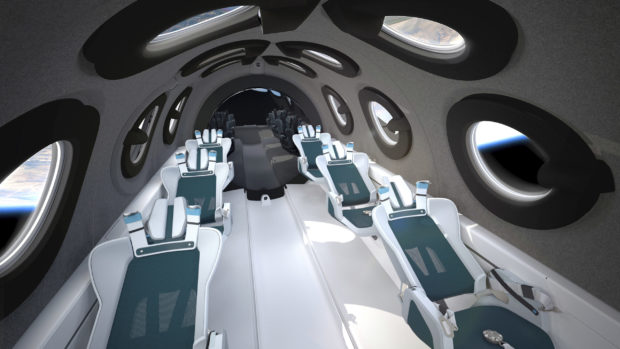‘Spaceline’ shows off passenger cabin interior

This undated photo released by Virgin Galactic shows the interior of their SpaceshipTwo Cabin during a flight. Highly detailed amenities to enhance the customer experience were shown in an online event Tuesday, July 28, 2020, revealing the cabin of the company’s rocket plane, a type called SpaceShipTwo, which is undergoing testing in preparation for commercial service. There are a dozen windows for viewing, seats capable of being customized to each of six passengers and mood lighting. (Virgin Galactic via AP)
LOS ANGELES — Passengers flying Virgin Galactic on suborbital trips into space will be able to see themselves floating weightless against the backdrop of the Earth below while 16 cameras document the adventures, the company said Tuesday.
Highly detailed amenities to enhance the customer flight experience were shown in an online event revealing the cabin of the company’s rocket plane, a type called SpaceShipTwo, which is undergoing testing in preparation for commercial service.
There are a dozen windows for viewing, seats that will be customized for each flight’s six passengers and capable of adjusting for G forces, and, naturally, mood lighting.
Yet designer Jeremy Brown said the passengers’ most lasting impression may come from a large mirror at the rear of the cabin.
“We think that there’s a real memory burn that customers are going to have when they see that analog reflection of themselves in the back of the cabin, seeing themselves floating freely in space … that very personal interaction that they’ll have with the experience,” he said.
Article continues after this advertisement‘Commercial spaceline’
Virgin Galactic, which describes itself as a “commercial spaceline,” was founded by British billionaire Richard Branson after the prize-winning flights of the experimental SpaceShipOne in 2004. Branson plans to be the first passenger when commercial flights begin.
Article continues after this advertisementLike its predecessor, SpaceShipTwo is a rocket plane that is slung beneath a special jet airplane and released at high altitude.
SpaceShipTwo was developed at Virgin Galactic facilities in Mojave, California, and will operate commercially from Spaceport America in southern New Mexico, where passengers will undergo several days of training before their flights.
The company has yet to set a date for flights with paying passengers.
The company has said more than 600 people have put down deposits. The initial seats were sold at $250,000 apiece. Whitesides said the cost may increase for a while but the long-term goal is to make the adventure more accessible, possibly at a lower cost.